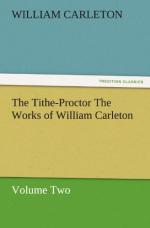The assizes came down at last. Darby lost all recollection of any money but the large public reward, and on that occasion over twenty men were hanged chiefly on his evidence—though it was very difficult for the crown counsel to bring the poor reluctant man to the point; but when he did make a convicting admission, he took care that it should be a clincher, wrung from him, as he wished it to appear, by a cunning counsel. The gallows at Limerick continued for years after to be fed by Darby with victims for this crime; and several hundred were transported, or went into voluntary banishment on account of this fearful butchery. The writer of this knew well, and was at school with the secretary of the Court of Kilteely Hill.
CHAPTER I.—The Chapel Green of Esker Dearg.
The chapel of Esker Dearg, or the Red Ridge, was situated in a rich and well-cultivated country, that for miles about it literally teemed with abundance. The Red Ridge under which it stood was one of those long eminences, almost, if not altogether, peculiar to Ireland. It was, as the name betokens, a prolonged elevation that ran for nearly a mile and a half in a north-eastern direction without appearing to yield to, or be influenced by, the natural position or undulations of the country through which it went. The epithet of red which was attached to it, originated, according to popular tradition, in a massacre which had taken place upon it during one of the Elizabethan wars, others imputed it to a cause much more obvious and natural, viz., its peculiar appearance during all seasons of the year, owing to the parched and barren nature of the soil, which, in consequence of its dry and elevated Position, was covered only with furze and tern, or thin, short grass that was parched by the sun into a kind of red-brown color.
Under that end of this Esker which pointed nearest to the south-west, stood the chapel we have just mentioned. It was a rather long building with double gables and a double roof, perfectly plain, and with no other ornament, either inside or out, if we except a marble cross that stood against the wall upon the altar, of which the good priest was not a little vain, inasmuch as it had been of his own procuring. A public road of course ran past it, or rather skirted the green unenclosed space, by which, in common with most country edifices, it was surrounded. Another road joined that which we have mentioned, within a few perches of it, so that it stood at what might be nearly considered a cross-road. One or two large trees grew beside it, which gave to its otherwise simple appearance something of picturesque effect, especially during the summer months, when they were thickly covered with leaves, and waved and rustled in the sun to the refreshing breezes of that delightful season.




